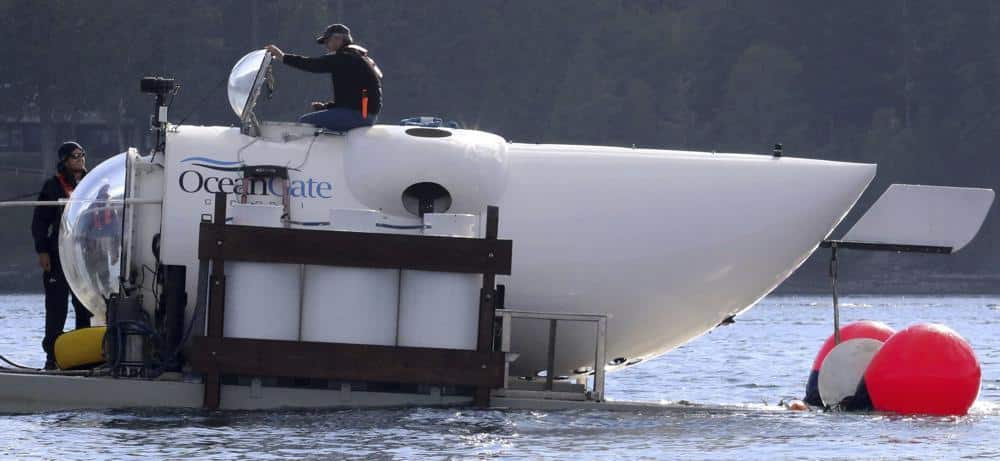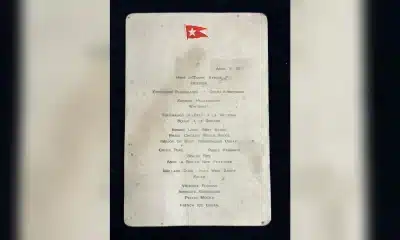Tech
Submersible Lost Near Titanic Wreck, In Race Against Clock, 41 Hours Of Oxygen Left

An increasing international fleet of ships and aircraft raced against time Tuesday to find a submersible that disappeared in the North Atlantic while carrying five passengers to the Titanic disaster.
U.S. Coast Guard officials said the search area was 10,000 square miles (26,000 square km), but there was no evidence of the Titan, a missing submarine. Time was running out because the vessel had fewer than two days’ worth of oxygen available, even though they intended to keep searching.
Cpt. At a press briefing, Jamie Frederick of the First Coast Guard District in Boston stated that “this is a very complex search” and that “the unified team is working around the clock.”
According to Frederick, as of Tuesday at noon, the crew had around 41 hours of oxygen left. He continued by saying that a push was being made to bring recovery equipment to the area in case the submarine was discovered and that an underwater robot had begun looking in the area of the Titanic.
According to a U.S. Air Mobility Command spokesman, three C-17s from the American military have also been used to transport a commercial company’s submersible and support gear from Buffalo, New York, to St. John’s, Newfoundland, to help with the search.
Authorities searched about 435 miles (700 km) south of St. John’s after receiving a report that the carbon-fiber sailboat was overdue on Sunday night. Pilot Stockton Rush, the CEO of the corporation organizing the expedition, was in charge. British explorer Hamish Harding, two members of a Pakistani business family, and a Titanic expert were among his passengers.
According to David Concannon, an advisor to OceanGate Expeditions, which organized the operation, the submersible had a 96-hour oxygen supply when it departed shore around 6 a.m. Sunday. That implies that the oxygen supply could run out early on Thursday.
The Titan employs two communication systems, according to CBS News correspondent David Pogue, who visited Titanic last year onboard the sub. These include text messages sent back and forth to a surface ship and safety pings sent out every 15 minutes to let people know the sub is still operational.
Both systems shut down about one hour and forty-five minutes after the Titan sank.
There are just two possible meanings for that. Either they lost all power, or the spacecraft experienced a hull breach, which caused an instantaneous implosion. According to Pogue, who spoke to CBC on Tuesday, both are utterly hopeless.
Aircraft raced against time Tuesday to find a submersible that disappeared in the North Atlantic while carrying five passengers to the Titanic disaster.
The submersible has seven backup devices to return to the surface, including an inflatable balloon, drop-off lead pipes, and sandbags. According to Pogue, one system is built to function even if everyone on board is unconscious.
Other events, such as an electrical fire that can produce toxic gases and put the crew unconscious, might have disrupted communications, according to Eric Fusil, head of the University of Adelaide’s Shipbuilding Hub.
Another option, according to Fusil, is that Titan got caught up in the Titanic’s wreck and is stuck there.
He remarked, “What I would like to believe is that Titan suffered from a power loss, but they could still go back to the surface, and they could still be seen by aircraft and surface ships.”
Experts claim that rescuers confront difficult obstacles.
Submersibles often feature a drop weight, according to Alistair Greig, a professor of marine engineering at University College London, which is “a mass they can release in the case of an emergency to bring them up to the surface.”
This may have happened, according to Greig, “if there was a power failure and/or communication failure, and the submersible would then be bobbing around on the surface waiting to be found.”
He added that another possibility is a leak in the pressure hull, in which case the outlook is not promising.
According to Greig, options are quite limited if it has descended to the seafloor and cannot ascend using its strength. Even while the submersible may still be intact, very few vessels—certainly not divers—can travel that far below the continental shelf.
The Canadian Boeing P-8 Poseidon reconnaissance aircraft was to continue assisting the Canadian research icebreaker Polar Prince, which was assisting the Titan, in performing surface searches, the Coast Guard announced on Twitter. Additionally, two American Lockheed C-130 Hercules planes flew overhead.
The Canadian military dropped sonar buoys to listen for any potential Titan sounds.
Aircraft raced against time Tuesday to find a submersible that disappeared in the North Atlantic while carrying five passengers to the Titanic disaster.
Archaeologists and marine biologists are on OceanGate’s excursions to the Titanic wreck site. Additionally, the business invites guests who have paid a fee. They operate the sonar apparatus and other submersible equipment in turns.
Rush stated to The Associated Press in June 2021 that NASA and aerospace firms assisted in developing Titan’s “very cutting edge” technology.
Rush referred to it as the “largest carbon fibre structure that we know of,” with titanium, which is 3.25 inches thick and carbon, fiber which is 5 inches thick. “This is the only submersible – crewed submersible – made of carbon fibre and titanium,” Rush said.
Harding, who resides in Dubai in the United Arab Emirates, Shahzada Dawood and his son Suleman, whose namesake company invests all across Pakistan, and French explorer and Titanic specialist Paul-Henry Nargeolet were among the passengers.
Rush’s friend and veteran ocean scientist Greg Stone described the missing submersible as “a fundamentally new submarine design” with much potential for future research. The Titan was not spherical like its predecessors.
“Stockton took chances. He had a vision and was intelligent. He wished to advance things, Stone stated.
The expedition was part of OceanGate’s third yearly trip to document the degradation of the Titanic, which sank in 1912 after colliding with an iceberg and killing all but about 700 of its 2,200 passengers and crew. The debris was found in 1985, and metal-eating microbes have been slowly destroying it.
The “mission support fee” for the 2023 expedition was listed on the OceanGate website as $250,000 per participant.
Pogue recalled his voyage on the Titan and said that the ship turned around while searching for the Titanic.
According to Pogue in a story on “CBS Sunday Morning,” since there is no GPS below, the surface ship must use text messaging to direct the sub to the shipwreck. But somehow, communication didn’t work on this dive. The sub failed to locate the wreck.
SOURCE – (AP)






































